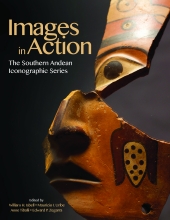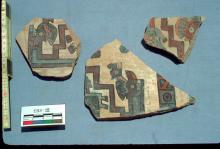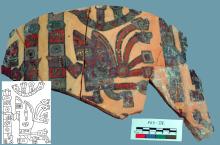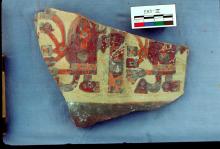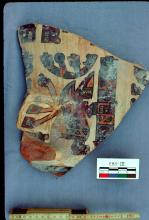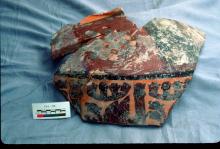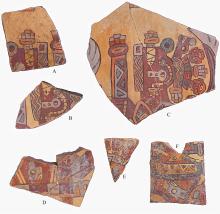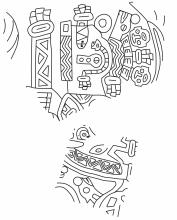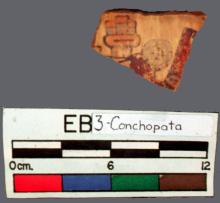Visual database
Details of the pyramidal pedestal on which the 1977 offering Staff God stands, showing the long-nosed head with toothy mouth and N-shaped canines who appears on the expanded and upturned lowest step of the pedestal.
Details of the pyramidal pedestal (far right) showing feline heads rising from the center box, as well as Staff God feet with circled dot in heel (in contrast to the more popular spiral in heel, see 15.13 and 15.28). Note that the background color of this sherd approximates the orange of the Ocros style more than the white characteristic of most sherds from the 1977 offering vessels. Other sherds show details of Profile Attendants from the 1977 Conchopata offering vessels.
Two rows of Profile Attendants accompanying the Staff God on the giant face-neck jars from the Conchopata 1977 offering. This vessel background approximates the color of the Ocros style.
Reconstruction (drawn by William H. Isbell) and details of a Profile Attendant from a giant face-neck jar from the Conchopata 1977 offering. This detail shows that the upper row of Profile Attendants who face away from the Staff God met face to face (or staff to staff) at the back of the jar.
This lower procession of Profile Attendants facing toward the Staff God shows some of the variation occurring among the vessels, including the hands of different artists, but perhaps also the use of different paints and other materials.
Processions of Profile Attendants were painted continuously over the handles of the giant 1977 effigy jars.
Details of shoulder area decorated with the checkered hand motif are located above the body section decorated with Profile Attendants, on a 1977 Conchopata offering jar. A noticeable angle separates these two sections.
Sherds discovered in 2003 with Staff God image (D), almost identical to the 1977 offering Staff God, but Profile Attendants, although fragmentary, are more consistent with southern SAIS imagery from Tiahuanaco and northern Chile.
Drawing of details of the 2003 Profile Attendant showing its N-shaped canines, a decorated chin band or bar, embedded limb bands, a short tufted ray at the mouth, what is apparently a belt, legs in the running or genuflecting position, a crown that consists of two bands, and a wing similar to those of Phase 3 (Agüero et al. 2003) sculptures from Tiahuanaco. This set of attributes combines features that range from Phase 1 through Phase 3 of the Agüero et al. seriation, as well as attributes best known in the snuff paraphernalia of northern Chile. Drawing by William H. Isbell.
A single sherd from the 1977 Conchopata offering pit is decorated with a Profile Attendant consistent with 2003 imagery. This shows that the 2003 jars belong with offering pottery smashed in the ceremonial area of Conchopata where the 1977 and 2000b offerings were discovered. The inclusion of this sherd also shows that the 2003 pottery is almost surely slightly earlier than the 1977 offering.
